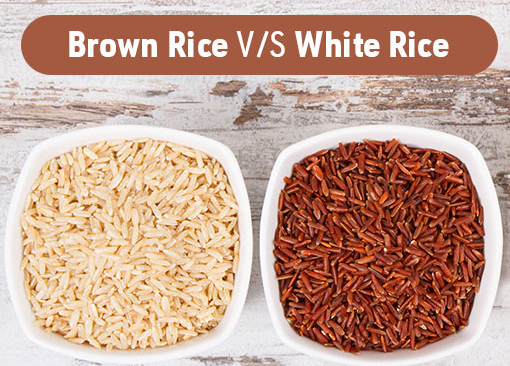BOURSESSENEGAL – When it comes to choosing the right type of rice for your meals, many people often find themselves asking, “What’s the difference between brown rice and white rice?” Understanding the distinctions between these two staples can help you make healthier choices for your diet. In this post, we’ll explore the nutritional benefits, cooking methods, taste profiles, and more, so you can decide which rice best fits your lifestyle.
What is Brown Rice?
Brown rice is a whole grain that retains its bran and germ layers. This gives it a nutty flavor and chewy texture. Unlike white rice, which undergoes milling that removes these outer layers, brown rice retains essential nutrients and fiber. This difference in processing significantly affects its nutritional profile.
Nutritional Benefits of Brown Rice
Brown rice is often touted for its health benefits. Here’s a closer look at what makes it stand out:
- High in Fiber: The bran layer in brown rice provides more dietary fiber, aiding digestion and promoting satiety.
- Rich in Nutrients: Brown rice contains important vitamins and minerals, including magnesium, phosphorus, and B vitamins.
- Low Glycemic Index: Its lower glycemic index means it releases glucose more slowly into the bloodstream, which can help manage blood sugar levels.
What is White Rice?
On the other hand, white rice is the more commonly consumed variety around the world. It’s milled to remove the bran and germ, leaving just the starchy endosperm. This processing gives white rice a softer texture and a quicker cooking time, but it also strips away many of its nutrients.
Nutritional Profile of White Rice
While white rice does have its merits, it’s important to consider its nutritional profile:
- Lower Fiber Content: The removal of the bran reduces fiber, which can impact digestion and satiety.
- Fortified Options: Some brands fortify white rice with vitamins and minerals, which can help compensate for nutrient loss during processing.
- Easier to Digest: For those with digestive issues, white rice can be gentler on the stomach.
Brown Rice vs. White Rice: Taste and Texture
The differences in taste and texture are significant. Brown rice offers a nuttier flavor and a chewier texture, making it an excellent choice for hearty dishes. Conversely, white rice has a mild flavor and a softer, fluffier texture, making it versatile for a variety of cuisines.
Cooking Methods: Brown Rice vs. White Rice
Cooking methods also vary between brown rice and white rice. Brown rice typically requires more water and a longer cooking time due to its outer bran layer. Here’s a quick comparison:
- Brown Rice Cooking Time: Approximately 40-50 minutes with a water-to-rice ratio of 2:1.
- White Rice Cooking Time: About 15-20 minutes with a water-to-rice ratio of 1.5:1.
These differences can influence your meal planning, especially on busy days.
Health Considerations: Brown Rice vs. White Rice
When choosing between brown rice and white rice, consider your health goals and dietary needs. Here are some important aspects to think about:
Weight Management
If you’re focused on weight management, brown rice might be the better option. Its higher fiber content can help keep you full longer, potentially reducing overall calorie intake. In contrast, white rice can lead to quicker spikes in hunger due to its lower fiber content.
Blood Sugar Control
For individuals managing diabetes or insulin sensitivity, brown rice generally offers more stable blood sugar levels. The lower glycemic index helps prevent rapid spikes, making it a more suitable choice for those concerned about blood sugar management.
Digestive Health
Brown rice promotes healthy digestion due to its fiber content. Conversely, white rice can be easier to digest for some people, especially those experiencing gastrointestinal issues. It’s essential to listen to your body and choose what feels best for you.
Culinary Uses: Brown Rice vs. White Rice
Both types of rice serve unique purposes in the kitchen. Understanding their culinary uses can help you decide which to incorporate into your meals.
Brown Rice Recipes
- Salads: Brown rice adds a hearty texture to salads. Combine it with vegetables and a light dressing for a nutritious dish.
- Stir-Fries: Use brown rice in stir-fries for added fiber and nutrition. It pairs well with various proteins and vegetables.
- Casseroles: Brown rice can serve as a nutritious base for casseroles, providing a chewy texture that enhances the dish.
White Rice Recipes
- Sushi: White rice is a staple in sushi-making, offering the sticky texture needed to hold rolls together.
- Risotto: The creamy texture of risotto relies on short-grain white rice, which absorbs flavors beautifully.
- Fried Rice: White rice works well in fried rice dishes, as it can quickly absorb sauces and seasonings.
Environmental Impact: Brown Rice vs. White Rice
Choosing between brown rice and white rice also raises environmental considerations. Brown rice typically requires less processing, which can mean a lower carbon footprint. However, the farming practices associated with rice cultivation can impact water use and ecosystems.
Sustainable Choices
When considering the environmental impact, look for sustainably sourced rice. Organic options often involve less pesticide use and promote better soil health. Supporting local farmers can also contribute to reduced transportation emissions.
Conclusion: Which Rice is Right for You?
Ultimately, the choice between brown rice and white rice depends on your health goals, culinary preferences, and lifestyle. If you’re looking for a nutrient-dense option that offers more fiber and a lower glycemic index, brown rice is an excellent choice. However, if you prefer a quicker-cooking, softer texture, white rice may suit your needs better.
As you navigate your dietary choices, consider trying both types of rice in various recipes. This can give you a fuller understanding of their flavors and textures, allowing you to make more informed decisions for your meals. Remember, balance is key, and enjoying a variety of foods can contribute to a well-rounded diet
REFERENCE : https://www.health.com/



